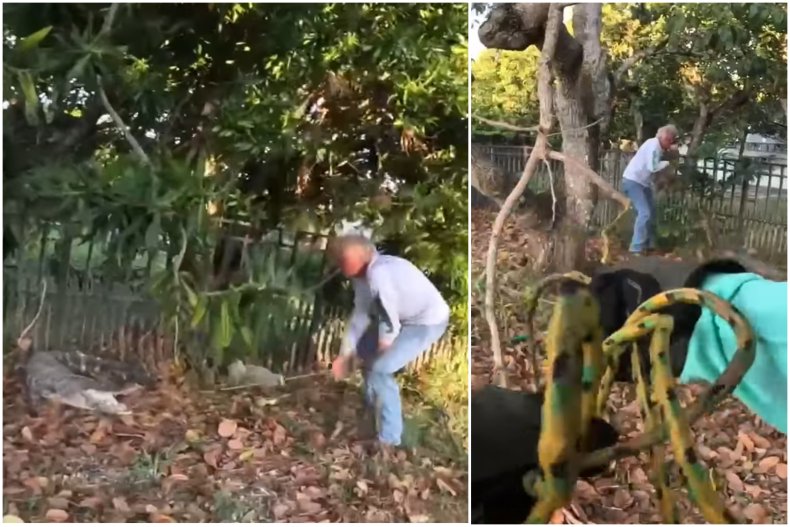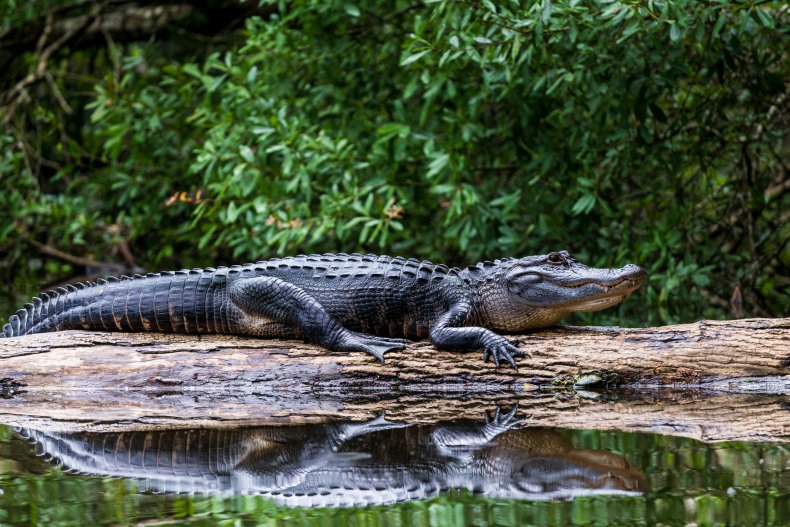Watch as 7-Foot Alligator on Run From Cops Death-Rolls in Florida Backyard
Have you ever wondered what alligator wrangling looks like from the trapper's perspective?
Trappers from Pesky Critters Wildlife Control in Florida used GoPro cameras to record the capture of a 7-foot gator from a property in Miami-Dade County's Redlands on March 11 and shared the footage on its Facebook page.
In the footage, the gator can be seen snapping and thrashing as it fights against the trappers.
"Anytime you have a gator on land, he's out of his element," Todd Hardwick, the owner of Pesky Critters, told Newsweek. "That makes the capture much more dangerous because the animal feels like he's at a disadvantage and he's quicker to battle with you and react."

Hardwick said this particular alligator was originally spotted on the road but had escaped into someone's backyard when the authorities arrived. "He was running from the police," he said.
In the video, Hardwick can be seen approaching the alligator and tying a rope around it. "As soon as we put a rope on him, he went into a death roll for 50 feet," Hardwick said.
A death roll is the rapid spinning motion alligators make when they capture their prey. "It's also their instinct when they feel in danger," Hardwick said. "They go into that spin and just roll and roll and roll."
This makes it harder for them to be restrained and also more likely that they will damage property. "I didn't want him to roll and tear up the fence, so I was trying to work him away from the fence as quickly as I could to avoid any property damage," Hardwick said.
Florida is home to over 1.3 million alligators, according to the state's Fish and Wildlife Conservation Commission. They are mostly found in swamps, marshes, rivers and wetlands, but at this time of year they often come into residential areas looking for food and a mate.

"Females generally remain in the Everglades and the wild areas, but the males—because they are so territorial with each other—end up coming into the neighborhood," Hardwick said.
During the winter, alligator sightings are less common. "Their metabolism slows down, and they're not feeding as much," Hardwick said.
However, as we move into spring, their activity begins to change. "Now that it's warming up, they're getting hungry, they're eating more, and their hormones are starting to stir," Hardwick said.
"We're not quite in breeding season yet, but we're right on the edge of it. We're in the time of year where the gators are starting to roam around and climb out of the river or canals and take a shortcut through neighborhoods and on roadways."
To stay safe around these apex predators, Hardwick has some simple advice. "I always tell everybody that if you see an alligator, you need to give him a wide berth—you know, stay 25 feet away from him—and you need to call the authorities and get the alligator team out there before something happens."
He continued: "If you have a dog, keep them on a leash and stay 20 feet from the edge of the water so that the gator doesn't try and get him. Avoid areas with heavy vegetation around water because that's where the alligator would be hiding.
"And above all, don't feed the alligators. Once you start feeding them, you condition them to come up to people, and that's when they become dangerous."

